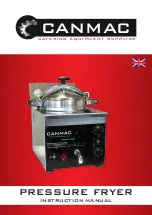
8
• Installation, conversion to a different type
of gas and appliance maintenance must
be carried out by qualified technicians au
-
thorized by the manufacturer, in complian-
ce with current safety standards and the
instructions given in this manual.
•
For after-sales service, contact technical
assistance centers authorized by the ma-
nufacturer and demand the use of original
spare parts.
•
Have the appliance serviced at least twice
a year. The manufacturer recommends ta-
king out a service contract.
•
The appliance is designed for professional
use and must be operated by trained per-
sonnel.
•
The appliance is to be used for cooking
food as specified in the prescriptions for
use. Any other use is considered to be im-
proper.
•
Do not allow the appliance to operate emp-
ty for prolonged periods. Only pre-heat the
oven just before use.
•
Do not leave the appliance unattended
while in operation.
•
In the event of an appliance fault or mal-
function, shut the gas shut-off valve and/or
switch the appliance off at the main switch
installed upline.
•
Clean the appliance following the instruc-
tions given in Chapter " INSTRUCTIONS
FOR CLEANING".
• Do not store flammable materials in close
proximity to the appliance. FIRE HAZARD.
•
Do not obstruct any air vents or drains pre-
sent on the appliance.
•
Do not tamper with appliance components.
• Do not use flammable products to clean
the appliance.
•
The use of personal safety equipment is
recommended - risk of very hot food being
scattered.
• During appliance operation, the floor sur
-
rounding the appliance may become slip-
pery: exercise caution and take all suitable
measures to prevent falls.
•
Take care when handling accessories (e.g.
pans) and movable parts of the appliance
to use the correct posture.
•
Appliances of this type are intended for
use in commercial applications such as,
for example, the kitchens of restaurants,
canteens, hospitals and businesses such
as bakers, butchers etc., but they are not
intended for the continuous mass produc-
tion of food.
USING THE FRYER
REMINDERS FOR USE
•
The appliance is designed for frying food in oil or solid fat.
•
Do not place large pieces of food or food that is dripping with
water in the well because this action may produce splashes
of boiling oil and cause the oil to overflow.
•
Top up the oil level whenever it falls below the minimum refe-
rence mark (fire hazard). Before pouring in oil make sure that
there is no water in the well.
•
Pour oil into the well up to the level indicated by the reference
mark on the well rear/side wall.
•
When using solid fat, melt the fat separately before pouring it
into the well. Do not leave the fat in the well when you have
finished cooking.
•
Gradually immerse the basket containing the food to be fried
into the boiling oil and take care that the resulting foam does
not spill over the sides of the well. If this should occur, stop
immersing the basket and wait for a few seconds.
•
Do not activate the heating system when there is no oil or fat
in the well.
•
While the fryer is on, the oil level must be maintained in cor-
respondence with or above the minimum level mark indicated
on the rear wall of the well.
•
The appliance is equipped with a manual reset safety ther-
mostat which interrupts heating when the operating tempera-
ture exceeds the maximum permitted value.
•
You have to pay particular attention to the fact that the old
fat and oil and the dirt, have a reduced ignition temperature
and will increase its tendency to boil suddenly and the foam,
which results, may overflow.
FILLING AND EMPTYING THE WELL
Filling
•
Turn handle of the drain valve.
•
Fill the well until the
oil
is level with or above the minimum
level ( bottom mark ) indicated on the rear wall of the well.
Emptying
• Switch the heating off.
•
Wait for the oil to cool
•
Connect the extension (if present) to the drain valve.
•
Place a suitable receptacle to hold the drained oil under the
drain extension.
•
Turn the drain valve handle slowly. Use caution when carrying
out this procedure. DANGER of scalding from hot oil.
GAS FRYERS
The control knob for the thermostatic valve has the following
positions:
Off
Summary of Contents for 7FRI/G415
Page 2: ......
Page 14: ...11 FIGURE ABB FIG...
Page 15: ...FIGURE ABB FIG Fig A Fig B 12...
Page 36: ...33...
















































